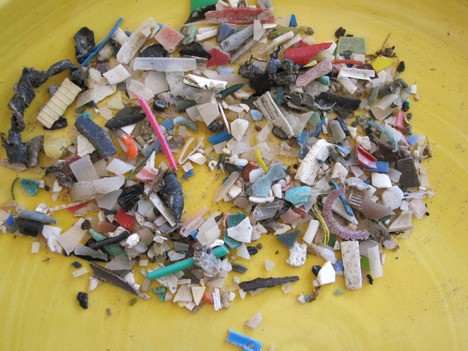Next time you’re out strolling the beach, pick up that stray lighter, empty chip bag, or bottle cap – you could be saving the life of a baby albatross. And it’s free to dump beach trash at country transfer stations.
When researchers on Midway Island (near Hawaii) looked to see why juvenile albatrosses were dying, autopsies found their stomachs filled with large chunks of plastic. Tracking the adults’ journeys led researchers to a “plastic soup” in the Pacific gyre, created by a whirling vortex of currents that pull in detritus from the Pacific Rim. The adult albatrosses were feeding their chicks the colorful debris, mistaking lighters for squid. Estimated to cover an area the size of Texas or larger, the “Great Pacific Garbage Patch” is growing rapidly.
Alarm over this and several other burgeoning garbage patches found in the world’s oceans has spurred the marine science community to further research.
The San Juan County WSU Beach Watchers have joined the Port Townsend Marine Science Center in marine micro-plastic pollution research, collecting samples from county beaches in April. This year’s results, covering 12 counties, were presented at the Citizen Science Summit on Micro Plastic Pollution in Puget Sound on May 14-15.
Orcas samplers targeted Fishing Bay (Waterfront Park) and Crescent Beach. Over 23 liters of material were collected from specific quadrants marked out at the high tide line of each beach, sorted through increasingly fine sieves and painstakingly documented. They found over 10,177 bits of 1-5 mm plastic in Fishing Bay, and only 300 at Crescent Beach.
Beyond the tragic issue of large plastics mechanically endangering sea life, such as sea turtles eating plastic bags that look like jellyfish, a more subtle danger has begun drawing researchers’ attention.
“The thing you have to remember about petroleum-based plastics is that they never biodegrade; they just break down into smaller and smaller pieces,” said Beach Watcher Marcia Spees. “The plastics we have right now will never go away. You won’t see them, but they’ll still be in the molecular environment. This is the real scary stuff because (it) gets into the food chain,” she said, holding up a bag of tiny plastic fragments. “Now you’re getting down to the microscopic level. These plastics are most likely being ingested by the smallest marine organisms in the food chain … microscopic plankton and algae, which take in whatever floats by. Some plastics absorb free-floating toxins, acting as an attractant.”
Bioaccumulation occurs as plankton ingest the potentially toxic particles and are then eaten by small fish, then increasingly larger fish like salmon, perhaps ending up on a dinner plate or inside an Orca whale.
Most trash on local beaches is not from the San Juans, said Spees. But without intervention, it’s headed to the center of the gyre.
Spees said researchers are trying to get a handle on both the magnitude of the issue and its implications.
“We’re dealing with something that’s pretty new and pretty dangerous. We’re trying to figure out how micro-plastics affect the entire web of life, and where they’re coming from,” she said. “(How) are these plastics affecting the health of marine organisms? Is it getting into the sediment of the ocean floor, into the filter-feeders at the bottom?”
She also wants to know why they are finding so many nurdles in the Salish Sea. A byproduct of petroleum processing, nurdles are lentil-sized, pre-production plastic pellets used to create plastic products. They closely resemble fish eggs, a marine staple food, and Waterfront Park is riddled with them.
To learn more, or to volunteer, contact Marcia Spees: speesart@centurytel.net.
For more information and photos of the Laysan albatrosses on Midway, see www.cnn.com
Reduce your plastic footprint
Courtesy of Marcia Spees
– Carry reusable shopping bags.
– Don’t buy bottled water; use a stainless steel bottle instead.
– Forget the plastic produce bags
– Bring your own mug or cup for that italiano or chai
– Choose glass over plastic whenever possible
– Wash the dishes: for your next big gathering, use non-plastic flatware, plates and glassware
Plastics are here to stay, but proper disposal can go a long way to keep plastics out of the food web.




